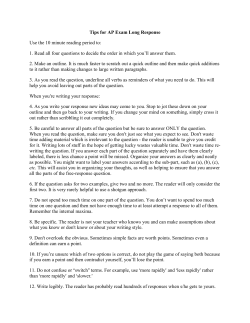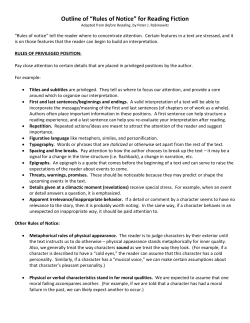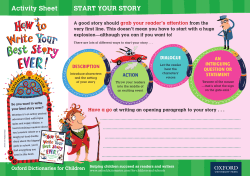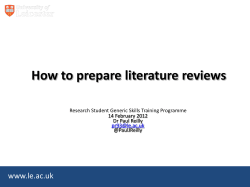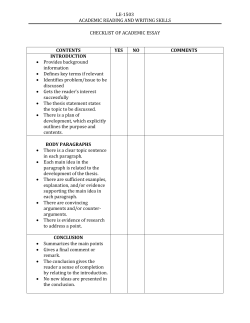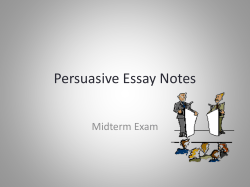
From The Compass - One Year Adventure Novel
Something to Learn 18 THE ONE YEAR ADVENTURE NOVEL Something to Learn, pt. 3 Meaning “Something to learn” is perhaps the most important element in any story. Without it, a story loses its power and influence when the curtains close, or the last page is turned or the final frame flickers to black. Conflict and character may be the defining traits of most stories, but their power is limited by how deeply they impact the reader. To put this another way, a story’s conflict must be meaningful in order to matter to the reader. In a story, characters must live meaningful lives or their lives won’t have any power to influence us. As readers, we come to stories because we are looking for meaning. What is meaning? Put simply, meaning is one thing pointing to another. When I write the word “chair” you think of something to sit on. When I say the word “rose” you picture a colorful, sweet-smelling flower. This is the essence of meaning, one thing (a word or a sound or a symbol) pointing to something else (such as an object or an action). In stories, meaning exists in four practical layers: 1. Words and symbols (punctuation) Words are meaningful because they point to objects, actions, modifiers, etc., outside themselves. They point to things that are predetermined by language: chair, jump, cat, red. 2. Sentences - created by combining words and symbols Sentences are meaningful because they cause certain words to point not just at predetermined objects or actions, but also at other words or punctuation within the sentence: The cat jumped over the red chair. 3. Context (everything that comes before and after) - created by combining sentences Contextual meaning is achieved when a sentence or group of sentences points outside itself to the sentences or events that come before it. Context is the reason the same sentence can mean different things in different situations. (Ever heard someone say that their words were “taken out of context”?) 4. Relevance - created by combining the story’s context and the reader’s context Relevance is achieved when something inside a story points outside the story to the reader’s life, the reader’s context. The four layers of meaning always work in chronological order. Before a 82 reader can understand your sentences, she must understand your words. Before she can understand your story’s context, she must understand your sentences. Before she can understand how the story is relevant, she must first understand what’s going on in the story, its context. This is important because it means that the four layers will not only be understood in chronological order, they will also be believed in chronological order. That is, your reader must be able to believe a story’s words before she will accept its sentences. She must believe in its sentences before she will accept the story’s context. And she must be convinced that the story’s context—its events and situations—are real within the framework of the story before she will see the story as relevant. To put this yet another way, a story’s prose must be convincing in order to sell the story, and its story must be convincing for the theme to impact the reader. Thus, the layer in which your reader stops believing is the point at which your story stops being meaningful. Why does this matter? In order to create meaning, you need to understand how readers find meaning in written words. “Something to learn” is the only one of the five basic elements of story that deliberately attempts to bridge the gap between the third and fourth layers of meaning. It’s the only element that lunges out of its pages to stab the reader in the heart. Of course, the main way it does this is through the use of ideals that convey a theme. But almost all stories that attempt to build relevance into their structure do so through one of two techniques. They either use character change or revelation to create a connection with the reader. Obviously, not all relevance comes through one of these techniques. But these are the two simplest and most powerful ways of demonstrating to your audience what your story means. Character Change The way a character changes in a story is perhaps the most significant aspect of any work of fiction. The way your hero changes will tell your reader what meaning you want her to attach to the events of the story. One word for this change is repentance, which means to turn around and go the other direction. As a storytelling device, it is as old as recorded history. We love to tell and hear the story of The Man Who Learned Better. It is a basic plot that is continually recycled, and yet it never fails when it is used well. There seems to be something inside every person that recognizes the power and beauty of a positive character change, even when we don’t want that same change for ourselves. In A Christmas Carol, Ebenezer Scrooge is a callous, selfish old miser who never troubles 83 THE ONE YEAR ADVENTURE NOVEL himself with the misfortunes of those around him. On Christmas Eve he is visited by four spirits, the first being the departed soul of his dead partner. He is given a warning about the direction of his life; but it is not until he experiences the events of the book that he really changes. As the story builds to a climactic moment of understanding for Scrooge, we are also masterfully manipulated into understanding and caring about Scrooge himself, in spite of his flaws. Scrooge’s change is portrayed through his actions and his words. He becomes good because of the events of the story. He changes, and in that change we see what Dickens intended. We get a glimpse of what Dickens believed about the ultimate meaning of life. Most stories use some variation of the character change, though often less dramatically. The questions to ask yourself as you craft your novel are: How will my hero change? What will he learn? Revelation A hero does not always change from bad to good. Sometimes it is from foolish to wise, or from ignorant to enlightened. Sometimes it is just a change in the way a character sees the world. Sometimes it is from good to better. But it is almost always a positive change; changes from good to bad will irritate your audience.* Have you ever seen the film It’s a Wonderful Life? George Bailey is the man who learned better. But we like him from the very beginning. He’s a good man. He does good, almost saintly deeds. He’s loved and respected by almost everyone. At the critical moment we understand that he believes a lie. The lie is this: “The world would be better off without me.” Which, in itself, is a rather noble kind of thing to believe. George Bailey, in his moment of crisis, doesn’t seem to be thinking about himself. He’s thinking about his family. He decides suicide is the answer. Help comes in the form of a bumbling angel named Clarence, who saves him from drowning by pretending to be drowning himself. George, being a heroic sort of person, jumps in the river to save Clarence. But it takes more than that to save George from the lie he has believed. Oh, George admits suicide was a bad idea. It would hurt his children. It would be better if he had never been born. In desperation, Clarence grants George the miracle he doesn’t think possible. He erases George’s life and shows him how the world would be different if he had never lived. The change is dramatic. George’s brother, Harry, died as a young boy when he fell through the ice while skating. George wasn’t there to save 84 him. Soldiers on a troop ship also died because a Japanese plane sank their ship. Harry, who had been a heroic pilot, wasn’t there to save them because George wasn’t there to save him. One by one the changes mount. We see the goodness of George’s seemingly plain life add up to heroic proportions. The climax of the movie comes when George rejects the lie of purposelessness and says, “I want to live again.” His character changes from good to great. And it happens because of a powerful revelation shown to us, the audience, as it is shown to him. Revelation is the cause of any character change. Revelation is what the man who learned better learns. And it is what he learns that makes him a different man, and a better man. Sometimes revelation comes in the form of a reinterpretation of the events of the story. That is, because of some new information, we look back at the rest of the story and see its events in a different way. This is the technique used in I Remember Mama. Uncle Chris is considered a drunken old man. In the climactic scene, we see the characters waiting around for him to die, wondering how much money he left behind. But there is no money. He spent it all on medical bills; not for himself, but for lame children. And suddenly we find new respect for the drunken old man, and the earlier events of the story begin to make more sense. How will revelation change your hero? What will he learn? How will he be different at the end of your novel? Reading: The Prisoner of Zenda, chapter 9 * I’m not ignoring tragedies. Even a tragedy like Romeo and Juliet depends upon positive character change. But it is the warring houses (and the audience) who learn the lesson. The men who learned better are Capulet and Montague. On the last page of the play we find: PRINCE: Where be these enemies? Capulet, Montague, See what scourge is laid upon your hate, That heaven finds means to kill your joys with love. CAPULET: O brother Montague, give me thy hand. This is my daughter’s jointure, for no more Can I demand. 85
© Copyright 2025
